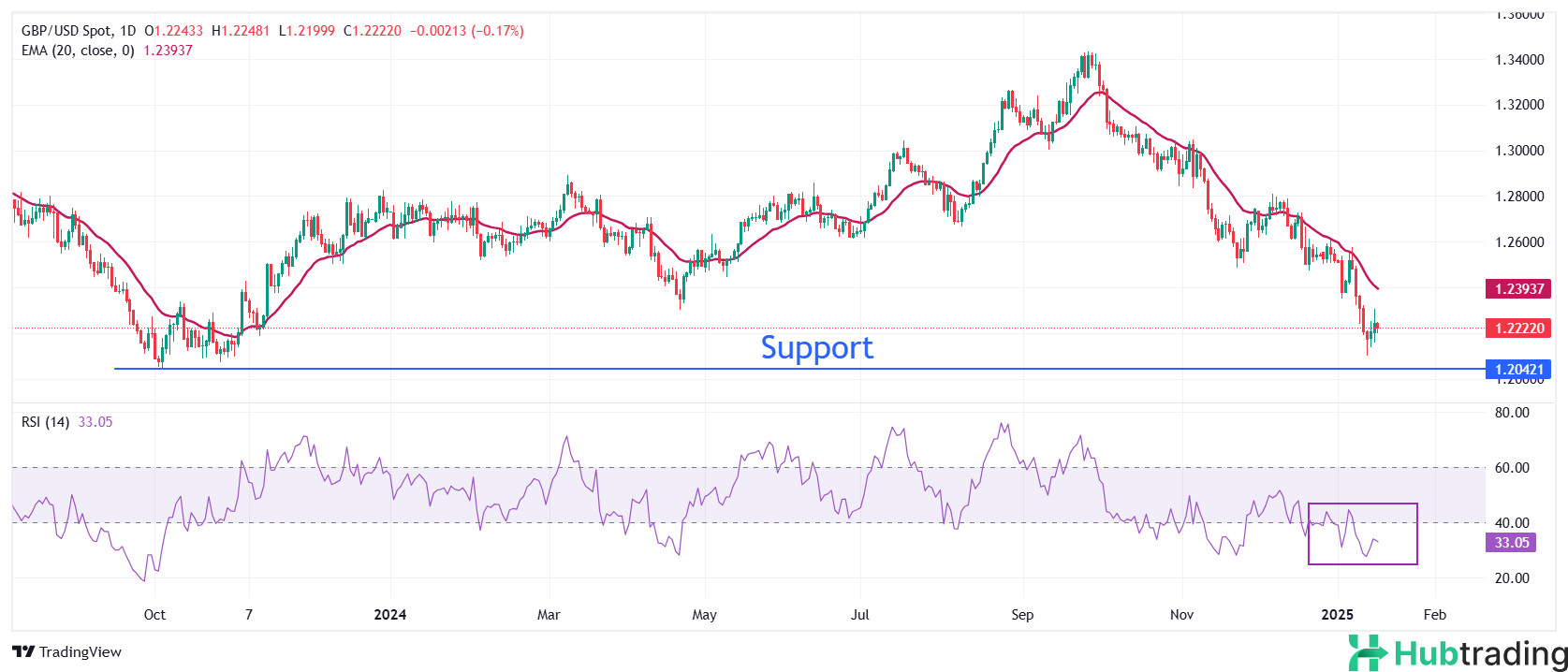- The Pound Sterling weakens as UK GDP growth falls short of expectations and factory activity contracts in November.
- Traders increase dovish bets on the Bank of England ahead of February’s policy meeting.
- Investors turn their attention to the US weekly Jobless Claims and December Retail Sales data, due Thursday.
The Pound Sterling came under selling pressure during Thursday’s North American session following the release of the United Kingdom’s (UK) November GDP and factory activity data. The Office for National Statistics (ONS) reported that the economy returned to growth after October’s contraction, but the expansion was slower than expected. GDP rose by 0.1% in November, below the 0.2% forecast, following a 0.1% decline in October.
Manufacturing and Industrial Production also showed contractions in November on both a monthly and annual basis. Month-over-month, Industrial Production fell by 0.4%, while Manufacturing Production declined by 0.3%, both performing worse than forecasts of 0.1% growth and flat activity, respectively. While the pace of decline was slower than October’s, the data indicates continued weakness in UK factory activity as producers scale back operations, anticipating further demand declines amid expectations of global tariffs under US President-elect Donald Trump’s administration.
Growing expectations for more aggressive monetary easing by the Bank of England (BoE) may provide some relief to manufacturers. Traders have increased dovish bets following the release of December’s UK Consumer Price Index (CPI) data, which showed signs of cooling inflation. There is now an 84% chance the BoE will lower interest rates by 25 basis points (bps) to 4.5% at its February meeting. For 2025, economists predict the BoE will implement four rate cuts, according to a Reuters poll.
Cooling inflation has also eased pressure on Chancellor of the Exchequer Rachel Reeves, as it has helped temper the rally in UK gilt yields. The yield on 30-year gilts has fallen to 5.28% after reaching a 26-year high of 5.47%. However, the British currency continues to struggle amid ongoing concerns about the economic outlook, with Sterling weakening significantly over recent trading sessions.
Daily Digest Market Movers: Pound Sterling Weakens Against USD
- The Pound Sterling remains under pressure, trading slightly below 1.2200 against the US Dollar (USD) during North American trading hours. The GBP/USD pair declines on weak UK economic data, while the US Dollar gains strength, with the US Dollar Index (DXY) hovering around 109.30. However, the USD may face selling pressure as US Initial Jobless Claims for the week ending January 10 came in higher than expected, and Retail Sales data for December showed moderate growth.
- The US Department of Labor reported that initial claims for unemployment benefits rose to 217K, surpassing the forecast of 210K and the previous reading of 203K. Meanwhile, monthly Retail Sales, a critical indicator of consumer spending, increased by 0.4%, missing the 0.6% estimate and below the previous growth of 0.8%. Yearly Retail Sales, however, showed improvement, rising 3.9% compared to the prior reading of 3.8%.
- Looking ahead, the US Dollar’s performance will depend on market expectations regarding the Federal Reserve’s (Fed) monetary policy decisions for the year.
- Market participants anticipate a less gradual policy-easing trajectory from the Fed. This outlook shifted after the December inflation report released Wednesday indicated that progress in the disinflationary trend continues.
- According to the CME FedWatch tool, traders now expect the Fed to implement more than one interest rate cut in 2025, with the first anticipated in June. Previously, markets had priced in only one rate reduction for September.
Technical Analysis: Pound Sterling Struggles Below 1.2200

The Pound Sterling continues to trade near the critical 1.2200 level against the US Dollar on Thursday. The outlook for GBP/USD remains bearish, as the sharply declining 20-day Exponential Moving Average (EMA), currently near 1.2394, signals sustained downward momentum in the short term.
The 14-day Relative Strength Index (RSI) has shown a modest rebound after falling below the oversold threshold of 30.00. However, the broader sentiment remains bearish as the RSI remains below the critical recovery zone of 20.00–40.00.
On the downside, the pair is likely to find strong support near the October 2023 low of 1.2050. Conversely, the 20-day EMA at 1.2394 will serve as a key resistance level for any potential upside recovery.





